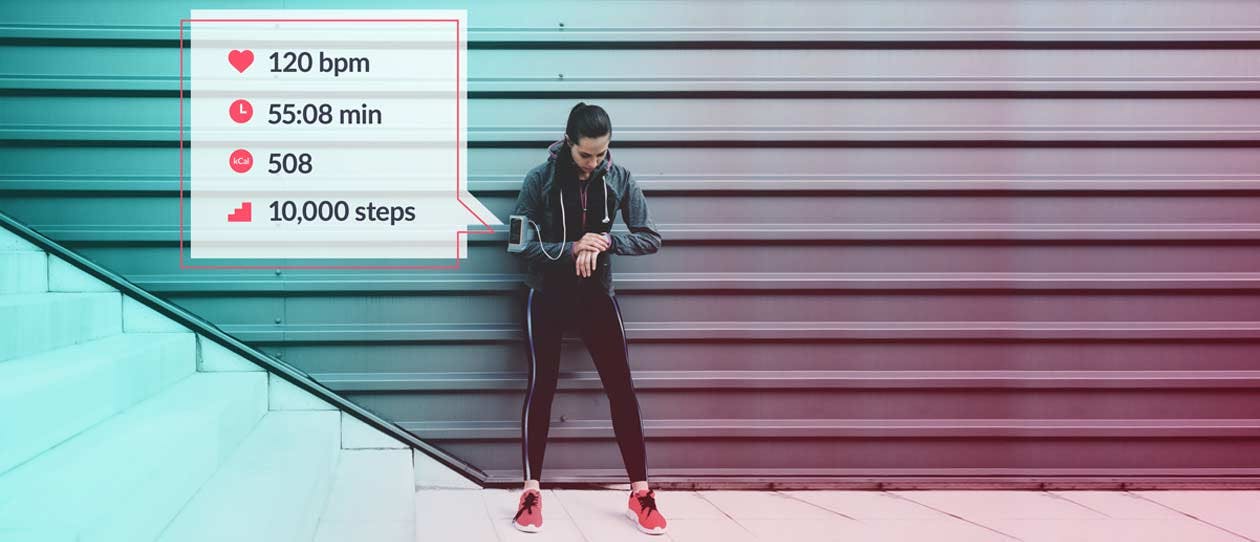2. Measure your exercise intensity
Rate of Perceived Exertion
Measuring intensity can be challenging, because what one person perceives as very high intensity could be very different compared to someone else.
One easy method to help measure exercise intensity is the rate of perceived exertion (RPE).
It’s basically a chart to rank your current level of effort performed during a workout. You can use this chart as a guide to your intensity, and the goals it can help you achieve.
|
Intensity |
You are... |
| 0 |
Complete rest, no exertion |
|
| 1 |
Extremely easy and light |
|
2 |
Very easy |
- Breathing easily
- Getting warm but not sweating
- Able to talk – and a show tune isn’t out of the question
|
3 |
Somewhat easy |
- Breathing easily
- Able to talk and sing
- Starting to sweat
|
4 |
Moderate |
- Breathing faster
- Able to talk but no longer sing
- Sweating more
|
5 |
Somewhat strong |
- Breathing faster
- Able to talk. Singing is a distant memory – just like the warm up…
- Getting sweaty now!
|
6 |
Strong |
- Huffing and puffing
- Sweating
- Able to talk but too focused on working out for that
|
7 |
Hard |
- Still huffing and puffing
- Sweating
- Talk? No time for that, I’m working out
|
8 |
Very hard |
- Breathing hard
- Sweating heavily from here on in
- It’s difficult to talk
|
9 |
Extremely hard |
- Breathing hard
- Sweating heavily
- Can’t… talk… … exer… cising…
|
10 |
Maximum exertion |
- Breathing hard
- Sweating heavily
- Talking is off the table
|
Levels 4 - 6 are ideal for fat burning, while levels 5 - 7 and more suitable for aerobic conditioning to boost your cardiovascular endurance.
Levels 8 – 10 are suitable for anaerobic training, which is an advanced form of training involving near maximal effort.
Target heart rate
One of the most accurate ways to measure exercise intensity is by working at your target heart rate (THR).
First, work out your maximum heart rate, which is calculated by subtracting your age from 220.
You can then work out at your target heart rate (THR) - a level that is a percentage of your maximum heart rate.
Moderate intensity exercise has a THR of between 50 to 70 percent. If you’re new to exercise start out within this range. As your fitness improves, or on days when you want to increase the intensity of your training, have a THR between 70% And 85%.
Days when you perform
interval training may also involve short bursts above 85% level, however, this should only be performed when you have established a solid base of fitness.
Keep a check on this as you exercise using a heart rate monitor, which come in many forms, including handles on an exercise machine, watches and chest straps.
Don’t have a heart rate monitor? You can also easily measure your heart rate by taking your pulse at regular intervals during your workout.
To take your pulse:
- Lightly press your first three fingers on the inside of your wrist and just below the thumb
- Using a watch with a second hand count your pulse for 10 seconds and then multiply this by 6 to get your beats per minute. For example if you get 20 pulse beats you get 120 beats per minute
3. Cycle your intensity
Make sure to intersperse your higher intensity workouts with lighter intensity workouts, and even rest days in between. Avoid performing two very high intensity workouts on consecutive days.
By cycling, or rotating your training load, your body (and mind) can better recover from any previous workouts, and prevent the problems associated with
over-training.
As your level of fitness advances, it is wise to plan different phases of intensity over a period of weeks or even months, especially if you are training for an event. This is sometimes referred to as periodisation.






